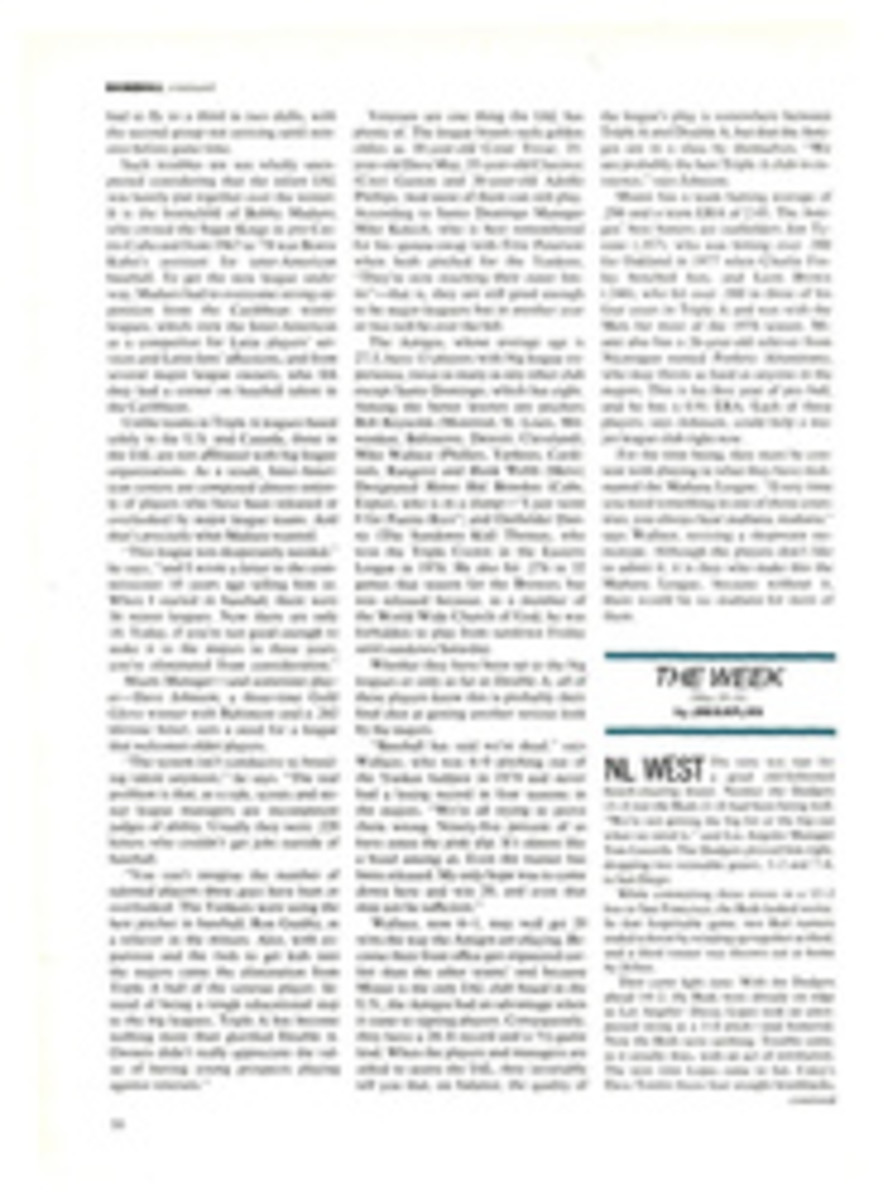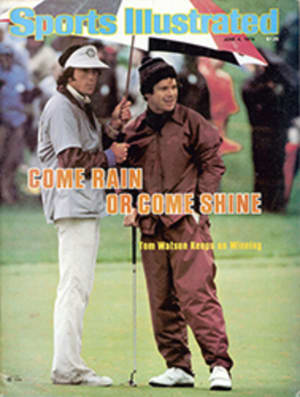
SCORECARD
PRICE TAG
Two years ago, when Los Angeles was bidding for the 1984 Olympics, Mayor Tom Bradley estimated the Games would cost $33.5 million. It now appears they will cost four times that much, or even more if some non-Olympic construction is approved.
Last week Bradley asked the Los Angeles City Council for permission to seek a federal appropriation of $141.2 million for capital construction and stadium facility improvements for the Games. City Administrative Officer Dr. C. Erwin Piper recommended that an additional $43.1 million be added to the request for construction of underground parking structures for 5,000 cars near the Memorial Coliseum. Bradley objected to this supplementary funding. "If any such proposal ever came to me," he told the Los Angeles Times, "I would veto it."
The major items in Bradley's request include $25 million to refurbish the Coliseum; $1.58 million to expand and revamp the Memorial Sports Arena; $19.4 million for an Olympic-size pool; $22.4 million for a velodrome; and $20 million for shooting and yachting facilities. These costs include an inflation factor of 33% as well as 20% for contingencies.
In his defense, Bradley says that the original estimate of $33.5 million was not his. He contends the figure was arrived at by the Southern California Committee for the Olympic Games, the original group involved in bidding with the IOC.
Moreover, the $141.2 million, in the opinion of Peter V. Ueberroth, the president of the organizing committee, represents only an anticipated 25% of the ultimate cost for the '84 Games.
Briefing congressional and federal administrative officials on the L.A. request, Ueberroth said in Washington last week that realistic Olympic budget estimates had yet to be made. He did estimate, however, that to meet a 42-month construction schedule for the various facilities, Congress would have to O.K. the funds by Oct. 1, 1979. It remains to be seen if that much money will be appropriated that soon. Early conjecture says it is doubtful. In any case, under the terms of the agreement reached last summer by the USOC and the L.A. organizing committee, the City of Los Angeles is still not responsible for any losses incurred by the 1984 Olympics.
SOUND IDEA
Sports technology, which already has developed the fiber-glass pole, the aluminum bat and the graphite shaft, now has come up with the electric tennis racket, which is designed to improve one's game through beeping.
The brainchild of inventor Skip Conrey, the racket has a lightweight battery-powered device in the handle, which creates a beeping sound when the ball hits the center of the racket.
The idea came to Conrey, a weekend player from Fort Lauderdale, after taking tennis lessons four years ago from Don Candy, who coaches Pam Shriver.
"The objective in tennis is to keep your eye on the ball and hit it in the center of the strings," Conrey says. "But the hardest thing to teach is to watch the ball hit the strings. Candy said I wasn't seeing the ball. He said, 'When you do, you'll hear a sound.' I said, 'What sound?' He said, 'The ping of a solid hit.' So I thought, 'Why not hear a sound like a beep every time?' "
Shortly after the lesson, a friend and partner, Phil McQuaid, gave Conrey a book called How to Invent and Get Rich. A week later he dreamed up the electric racket, which has been patented but is not yet on the market.
When it is, the beeps may eliminate some bleeps.
BUM'S NO BUM
When a schoolteacher in Houston told her fifth-grade class to write a paper on the two greatest heroes in Texas' history, one student's entry was Jim Bowie and Bum Phillips.
Bowie, of Alamo fame, seemed a logical choice, but Phillips, head coach of the Houston Oilers?
"Bum Phillips made a football fan out of my mother," the youngster said. "If he can do that, he has to be a hero."
TRASH AND TRINKETS
Following the Preakness, the infield at Pimlico was strewn with 140 tons of garbage that took 200 men most of the next day to cart off. The removal crew estimated that 80% of it consisted of empty beer, wine and liquor containers, with a curious contrast between the empties at the start and finish lines. Wine was the favorite at the start, bourbon predominated at the wire, and beer was the top choice in the middle of the infield.
The trash also included such unexpected items as several green tennis balls, a canary cage, assorted men's and women's underwear, half an ounce of marijuana and unmistakable evidence that Pimlico had been visited by a cow.
If the above leaves you feeling down in the dumps, be advised that a Baltimore jeweler named Fred Brown followed up on the Preakness by unveiling a new line of baubles suitable for racegoers everywhere.
Brown's 18-karat gold stirrups, bridles, horses' heads and other trinkets sell for from $200 to $1,500. He calls them "Spectacular Bits."
TRIPLING THE TRIPLE
For 25 years, from Citation in 1948 to Secretariat in 1973, no thoroughbred was able to win the Triple Crown—the Kentucky Derby, the Preakness and the Belmont Stakes. Some horsemen even said there might never be another Triple Crown winner because it was too much to ask of a still maturing 3-year-old. Besides, they pointed out, with the number of foals increasing from 5,819 in Citation's birth year of 1945 to 24,954 in Secretariat's birth year of '70, the chances of one colt's winning all three races had to be greatly reduced.
Now, though. Spectacular Bid is expected to win the Belmont on June 9, just as he did the Derby and Preakness, and become the fourth Triple Crown winner in seven years and the third in a row. How can this be?
Good breeding, says Trainer Johnny Longden: "It's way up in quality. There are so many high-class stallions now and a lot of good broodmares. There's got to be one good one from all those horses."
Poor breeding, says Trainer Jimmy Jones: "We're raising more horses than ever, but we're not coming up with that many good ones. It seems that we're coming up with one right-good horse and the rest don't amount to much."
More racing in the U.S., says Trainer Laz Barrera: "Now they run the whole year round all over the United States."
Other experts cite poor racing luck during the 25-year drought, circumstance, better feed, faster tracks or an unfavorable alignment of the planets. The truth is that no human knows for sure and the horses aren't talking.
CHANGE OF PACE
In an era of skyrocketing athletes' salaries, Hessianlike free agents, and contracts that are binding only until renegotiated, many fans have branded all athletes as greedy and selfish. In rebuttal, consider these three incidents which took place recently in Texas: 1) Bruce Lietzke won the $1,500 first prize in a Beaumont pro-am golf event and gave his winnings to charity. 2) Roger Staubach won $3,000 in a pro-celebrity tennis tournament in Houston and turned his check over to the Muscular Dystrophy Association, which was the event's beneficiary. 3) Fred Couples of the University of Houston tied Payne Stewart of SMU for the Southwest Conference golf championship, whose winner was invited to play in the Colonial Invitational in Fort Worth. It had been decided that in case of a tie, players would use regressive matching—that is, comparing hole-by-hole scores, beginning with 18—to determine a winner. Because Couples won the 15th hole, he deserved to be the SWC champ.
But when he found that Stewart was a senior who might never have another chance to play in the Colonial, Couples said, "Let's play it off. I'm only a sophomore, and I've got two more years." Stewart shot a par 4 on the 1st hole to win the playoff.
In a letter to Couples, Bill Morgan, the SWC information director, said, "Word may get around that you lost that playoff to Payne Stewart for the invitation to the Colonial, but anybody who did what you did is the real winner. Thanks for giving everyone a refresher course in what sportsmanship means."
SELF-STARTER
Three hundred and thirty-four athletes were selected in this month's NFL draft, and while none of them yet has played a single down of pro football, Richard Kirk already leads the 1979 rookie crop in initiative.
A 6'2", 234-pound defensive end, Kirk correctly assumed last season that few NFL scouts, if any, would see him play for Ohio's tiny Denison University, a school whose football program is best described as modest.
So, since the buyers weren't likely to come to Kirk, Kirk decided to send himself to the buyers. Enlisting the help of his older brother, Gilman Jr., Kirk produced a one-reel color film that just happened to feature the best football plays of Richard Kirk.
Kirk & Kirk Productions spent about $2,000 on their promotional movie—which Gilman shot on location—including the cost of mailing the finished print to several NFL clubs.
No team was more impressed with the Kirks' camerawork than the Pittsburgh Steelers. Bill Nunn, the assistant director of player personnel, said the film was "as professional as an MGM production," and shortly thereafter sent two Steeler scouts to time and grade Kirk in several physical tests, which the young moviemaker passed with almost Oscar-winning performances. In the football 40-yard dash, Kirk's time of 4.55 seconds was faster than that of any other lineman drafted. Pittsburgh selected Kirk in the ninth round.
"Now we'll have to see if he can play football," one Steeler aide said last week. If not, Kirk's future seems assured as a team cameraman—if Hollywood doesn't draft him, of course.
ABSENT AMPHIBIANS
Maybe they've all been kissed and turned into handsome princes, but there apparently is a serious frog shortage in the land. Our authority is Gib Hedstrom, 70, of Alexandria, Minn., a professional frog picker who is hopping mad about the situation. He is having trouble capturing the 2,000 frogs used annually for research at the University of Minnesota.
Once Hedstrom traveled in Canada and six or seven Midwestern states picking up to 300 pounds of frogs a day. Now, he says, crop pesticides are washed by rain into the meadows, lowlands and rivers, and people are "doing away with the marshes, potholes, small slough holes and wherever there is water. They're draining everything. There's nothing left for the birds, fish or frogs, and frogs have to have water."
EXAM AT EWE U.
Tryouts for the 1979 Los Angeles Rams cheerleading squad—unofficially known as the Embraceable Ewes—included a 13-question quiz on pro football. Only 31 of the 115 test takers got passing grades. One candidate listed All-Pro Defensive End Jack Youngblood as the Ram quarterback. Another thought the 49ers won the Super Bowl (they won two games all season). Estimates of the number of NFL teams ranged from four to 61. Two who flunked the test still made the squad. Obviously they were graded on different curves.
COUNTERATTACK
When a boorish lout cut in ahead of several other cars waiting in line for gasoline in Los Angeles last week, the driver immediately behind him jumped out of his car in a rage. The rude motorist, however, figured he was safe because his windows were rolled up and his doors were locked.
He didn't get off so easy. The victimized driver just happened to have one of those locking gas caps on his car and, shortly after removing it, was delighted to find that the line jumper had an ordinary gas cap. Striking a blow for justice, the victimized driver traded caps, locked the rude driver's tank and drove off.
ILLUSTRATION
THEY SAID IT
•Fred Akers, University of Texas football coach: "Football doesn't take me away from my family life. We've always watched films together."
•Ted Turner, Atlanta Braves owner, on the team as a tax shelter: "They're a shelter all right. A bomb shelter."

